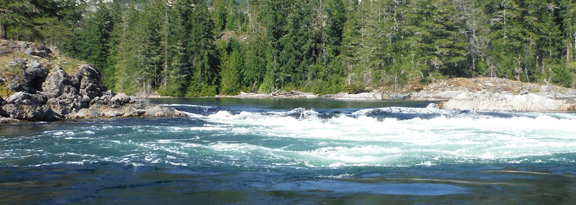
23 Jun Sechelt Rapids, why they run so fast
this phenomena explained
Skookumchuck Narrows and Sechelt Rapids are natural phenomena. They are not unique. The physical conditions that create this attraction exist in many places. However, this example is extra ordinary in that it is the fastest tidal generated current in North America. In addition, it is very easy to access.
We’re fussy about the names here
Officially, it is the Skookumchuck Narrows and the Sechelt Rapids.
Because Sunshine Coast Tours often deals with professionals or experienced operators from other areas, the names are important. Without the correct place name, you will not find records created by the Canada Hydrographic Service. They make tide and current projections and manage official charts.
If you are a white water kayaker looking for the Skookumchuck Rapids, head for interior BC. That name applies to rapids on the Shuswap River near Enderby BC
Understanding
get started with important terminology
It is easier to understand the phenomena if you use the right terminology.
Tide is the rhythmical rise and fall of the ocean. Our ocean waters move in response to the gravitational pull of the planets. Because the moon is closest, it is the biggest single factor that affects tide. When mariners ask about tide, they are generally looking for information about depth of water.
Tides are not regular because the distance from the planets is not constant, and because the alignment of the planets changes. Some cycles have shorter periods between high and low tide. Range of the tide varies from day to day. In addition, because the lunar cycle is not the same as the solar cycle we use to set our clocks the timing of high or low tide changes each day.
Current is the horizontal movement of water. While most surface currents are wind generated many other factors can create or contribute to current. Tidal currents are those associated with tide changes.
As tides change so do currents that are associated with tides.
For best viewing, or safe passage times use projections shown in current tables, not tide tables. With the right formula, you can calculate current speed from tide data. However, without a PhD in math, it is hard to understand. It is easier to reference the work already done by Canada Hydrographic Service.
This may be a good time to point out that Canada Hydrographic Service is the only one collecting data from site. Their annual projections are the best information available. Others buy data from them to publish projections. We have seen published tables generated from very old data. This negatively affects accuracy.
Why is there current?
and why is it so fast
In open oceans, water movement associated with tide changes can be very slow. In places like the Strait of Georgia, it may run around two knots.
Current speeds increase where the water flow is restricted. Land formations can create a natural venture, a” pinch”. Velocity of fluid flow increases where restricted. The easiest practical demonstration of this is squeezing the garden hose.
There are a few places in BC where current is extreme. Nakwakto Rapids and Seymour Narrows are two of the other well-known current stations that closely rival the 16.5 knots you can see in Sechelt Rapids.
Interesting to note here that the extreme current in Sechelt Rapids is not because of a huge volume of water going through the restriction. Rather it is that only a small portion of the water trying to pass through can. The resulting backup makes for higher water on one side. Higher water builds more pressure. More pressure increases flow rate (current speed). The venture effect increases current to an extreme.
Is this worth viewing?
Absolutely!
Sechelt Rapids is a spectacular example of the power of nature. The tour boat makes an ideal platform to experience this. Join a Skookumchuck Narrows tour and see the whole of the Narrows including time in the Rapids area. Let us show you how our lives have evolved and adapted as we live beside this force.
